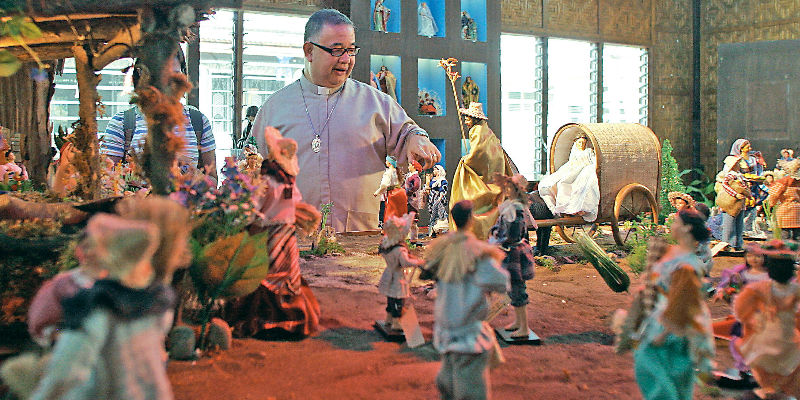Cebu sources feel betrayed by writer of NatGeo story

BELEN COLLECTION Msgr. Cris Garcia shows off his collection of Belens housed at the Collegium Societatis Angeli Pacis Immaculate Heart of Mary Refuge in Cansojong Talisay City, in this file photo taken on Dec. 20, 2008. Garcia said some pieces in the collection were a century old. LITO TECSON/CEBU DAILY NEWS
CEBU CITY—Heritage experts and conservationists cooperated with National Geographic writer Bryan Christy when he told them that he was writing about Cebu’s devotion to the Holy Child Jesus.
But they felt betrayed after they had read Christy’s article online linking the veneration of the Sto. Niño to the killing of elephants for their tusks, one of the sources of ivory.
“If we knew [that he was writing about ivory icons], we would not have cooperated with him,” said Trizer Dale Mansueto, a Cebu-based historian involved in heritage conservation.
“We cooperated because we thought the story was about the devotion,” he said. “He never mentioned that he was writing about ivory.”
Christy sent Mansueto an e-mail on Sept. 25, explaining that he did not seek to call attention to ivory smuggling in the Philippines, but to make readers think about the many kinds of devotion, including to wildlife.
Article continues after this advertisementIllegal ivory trade
Article continues after this advertisementThe publication of his article, “Ivory Worship,” in the October issue of National Geographic called attention to an illegal trade in ivory in the Philippines, which signed the Convention on International Trade in Endangered Species of Wild Fauna and Flora in 1981.
Christy’s article also drew attention to a vast collection of religious icons made of ivory owned by a Roman Catholic prelate, Msgr. Cris Garcia of the Archdiocese of Cebu, whom the Vatican suspended in June pending the resolution of charges that he molested two altar boys in the United States 20 years ago.
The article pictured Garcia as having extensive knowledge of the ivory trade in the Philippines, the ivory-carving industry, and the illegal transport of ivory across borders.
A report on Christy’s article published by the Inquirer on Sept. 25 called the government’s attention, leading to an investigation headed by the Department of Environment and Natural Resources (DENR).
Dating ivory
The National Bureau of Investigation is conducting its own investigation, centered on Garcia and the source of ivory used by icon carvers.
But the DENR has no knowledge of dating ivory, which may frustrate the investigation that covers not only Garcia’s collection but also icons in private collections acquired after 1981.
Isabelo Montejo, DENR director for Central Visayas, said the department had no experts who could date ivory.
The skill is needed in the investigation for establishing whether ivory icons under examination date before or after 1981, the year the ban on ivory trade took effect in the Philippines.
To fill the gap, the DENR is planning to ask the National Museum of the Philippines to help it date ivory.
Montejo said experts from the museum would be able to help the DENR in dating and tracing ivory that had left the Philippines through papers filed in the Bureau of Customs.
DENR officials said the investigation would begin with Garcia’s icons, then extend to other collections.
Montejo assured private collectors they had nothing to worry about if their icons were legally acquired.
Honest story
In his e-mail to Mansueto, Christy wrote:
“While much is being made of the smuggling part of the story, I also think the main point of the story is to get people to think about the many kinds of devotion—to God, to wildlife, to ecosystems, to legal systems. It is only by global understanding that the world can improve,” Christy said.
He said he spent a great deal of time understanding the deeper meaning of holy images in Cebu and other parts of the Philippines.
“It was important to me that I tell a story that was honest to the people and their religious beliefs. I tried very hard not to bring any judgment to the story but to let those in it reveal their own motivations,” Christy said.
“I hope there is now an opportunity for Catholic leaders to press the Church’s core values of honoring life to protect those who are subjected to corruption caused by the ivory trade, which is causing so much harm around the world not only to elephants but also to rangers, African citizens and honest Filipinos,” he added.
But Mansueto said Christy’s letter didn’t appease the heritage experts and conservationists, who felt the journalist misled them.
In his response to Christy dated Sept. 26, Mansueto informed the journalist that his article caught him and the others offguard.
Storm
The article, he said, created “some storm” in the Philippines, particularly in Cebu.
“I should be honest with you, we have been expecting that you’d write about the Sto. Niño and our cultural traditions but we are disappointed that after all, we Filipinos would be portrayed as fanatics, idol worshippers, smugglers, etc. in a rather appalling story,” he said.
“On the spiritual side, you know that not all Filipinos worship idols (in this case, in ivory) but we venerate them. Although I don’t have ivory images myself, I would like to clarify that Cebu has never been a transshipment point for smuggled ivory,” he added.
Mansueto told Christy that Cebuano collectors bought their ivory icons in Manila.
Sad for Garcia
He also told Christy that he felt sad for Garcia, saying he should not have written about the child abuse case, which led to the prelate’s suspension.
Mansueto told Christy that he didn’t know Garcia personally but he also didn’t expect the journalist to “whack him that hard.”